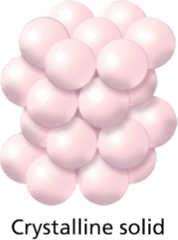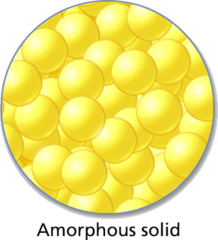CHEM 122 Chp 11. – Flashcards
Unlock all answers in this set
Unlock answersquestion
Intermolecular Forces
answer
The attractive forces that exist among the particles that compose matter.
question
Thermal Energy
answer
The energy associated with the movement of molecules and atoms.
question
Crystalline Solids

answer
Atoms and molecules are composed in 3D. (Ordered Structure)
question
Amorphous Solids

answer
Atoms and molecules have no long-range order.
question
Dispersion Force
answer
Weakest Force: Exhibited in all molecules and atoms. Result of fluctuations in electron distribution.
question
Which halogen has the highest boiling point? Cl2 Br2 I2
answer
I2
question
Polar Molecules
answer
A partial negative charge and a complementary positive charge. Asymmetric.
question
Miscibility
answer
The ability to mix without separating into two states.
question
What kind of molecule is miscible with water?
answer
A polar molecule.
question
Which molecules have dipole forces? CO2 CH2Cl2 CH4
answer
CH2Cl2
question
Which molecules have dipole-dipole forces? Cl4 CH3Cl HCl
answer
CH3Cl HCl
question
Hydrogen Bonding
answer
When H is bonded with N, O or F.
question
Rank from highest IM force to lowest. Dipole-Dipole Dispersion Hydrogen Bonding
answer
Hydrogen Bonding -> Dipole-Dipole -> Dispersion
question
Ion-Dipole Force
answer
When an ionic compound is mixed with a polar compound. (Aqueous solutions).
question
Which substance has the highest boiling point? CH3OH CO N2
answer
CH3OH
question
How many hydrogen bonds does Thymine and Adenine have? Cytosine and Guanine? (DNA)
answer
3 2
question
Surface Tension
answer
The energy required to increase the surface area by a unit amount.
question
As IM forces decrease, surface tension..... decreases increases stays the same
answer
Decreases
question
Viscosity
answer
The resistance of a liquid to flow.
question
Substances have greater viscosity when they have ________ IM forces. Higher Lower
answer
Higher
question
Viscosity increases as molecule size _________________. Increases Decreases
answer
Increases
question
What SAE oil would a car need for the summer?
answer
A high SAE number oil.
question
Capillary Action
answer
The ability of a liquid to flow against gravity up a narrow tube.
question
What two forces result in capillary action?
answer
Adhesive forces and cohesive forces.
question
Adhesive Forces
answer
The attraction between molecules and the surface of a tube.
question
Cohesive Forces
answer
The attractions between the molecules themselves.
question
Vaporization
answer
The transition of a liquid to a gas.
question
Condensation
answer
The transition of a gas to a liquid.
question
______________ IM forces cause a higher evaporation rate. Stronger Weaker
answer
Weaker
question
Volatile Chemicals
answer
Chemicals that evaporate easily.
question
Nonvolatile Chemicals
answer
Do not evaporate easily.
question
______________ temperatures cause higher evaporation rates. High Low
answer
High
question
________________ surface areas cause higher evaporation rates. Large Small
answer
Large.
question
Is vaporization endothermic or exothermic?
answer
Endothermic
question
Is condensation endothermic or exothermic?
answer
Exothermic
question
Enthalpy of Vaporization
answer
The amount of heat required to vaporize 1 mole of liquid to a gas.
question
What is the Enthalpy of Vaporization for water?
answer
ΔHvap = 40.7 kJ/mol
question
Dynamic Equilibrium
answer
When the rate of a reverse process equals that of the forward process. ex- when condensation = evaporization
question
Vapor Pressure
answer
The pressure of a gas in dynamic equilibrium with it's liquid.
question
Boiling Point
answer
The temperature at which the liquid's vapor pressure equals the external pressure.
question
Normal Boiling Pt.
answer
The temperature of a liquid where its vapor pressure equals 1 atm.
question
Supercritical Fluid
answer
Any substance beyond its critical point.
question
Critical Temperature (Tc)
answer
The temp above which a liquid cannot exist regardless of pressure.
question
Critical Pressure (Pc)
answer
The pressure required to bring about a transition to a liquid at Tc.
question
What properties do supercritical fluids hold?
answer
Liquid and Gas
question
Sublimation
answer
Solid to a gas
question
Deposition
answer
Gas to a solid
question
What is an example of sublimation?
answer
Dry Ice
question
Fusion
answer
Melting; Solid to a liquid
question
Freezing
answer
Liquid to a solid
question
Is fusion endothermic or exothermic?
answer
Endothermic
question
Heat of Fusion
answer
The amount of heat required to melt 1 mol of a solid.
question
Is freezing endothermic or exothermic?
answer
Exothermic
question
Enthalpy of Sublimation
answer
The amount of heat required to sublime 1 mol of a solid to a gas.
question
Phase Diagram
answer
A map of the state(phase) of a substance as a function of pressure (y) and temperature (x).
question
Triple Point
answer
Where all three states exist in equilibrium.
question
Critical Point
answer
Represents the temp and pressure above which the supercritical point exists. Where a liquid and gas can no longer be distinguished.
question
Dipole-Dipole Forces
answer
Exists between all molecules that are polar.
question
Permanent Dipole
answer
When two atoms in a molecule have substantially different electronegativities.
question
Sometimes when we heat food in the microwave, the lid of the container pops off. Why does this occur?
answer
The air and water vapor inside the container are expanding.
question
A substance with a fixed volume and fixed shape.
answer
Solid
question
A substance with a fixed volume but no fixed shape.
answer
Liquid
question
A substance with no fixed volume or shape.
answer
Gas
question
What factors cause changes between the liquid and gas state? A gas can be converted into a liquid by heating. A gas can be converted into a liquid by cooling. A liquid can be converted to a gas by heating. A gas can be converted into a liquid by increasing the pressure of a gas sample. A gas can be converted into a liquid by decreasing the pressure of a gas sample. A liquid can be converted to a gas by cooling.
answer
A gas can be converted into a liquid by cooling. A liquid can be converted to a gas by heating. A gas can be converted into a liquid by increasing the pressure of a gas sample.
question
What factors cause changes between the solid and liquid state? A solid can be converted to a liquid by heating. A liquid can be converted to a solid by cooling. A liquid can be converted to a solid by heating. A solid can be converted to a liquid by cooling.
answer
A solid can be converted to a liquid by heating. A liquid can be converted to a solid by cooling.
question
What are the main properties of liquids (in contrast to gases and solids)? Liquids have a definite volume. Liquids have much higher densities in comparison to gases. Liquids have an indefinite shape and do not assume the shape of their container. Liquids are easily compressed. Liquids have an indefinite shape and assume the shape of their container. Liquids are not easily compressed. Liquids do not have a definite volume. Liquids have lower densities in comparison to gases.
answer
Liquids have a definite volume. Liquids have much higher densities in comparison to gases. Liquids have indefinite shape and assume the shape of their container. Liquids are not easily compressed.
question
Which substance has the highest boiling point? CH3OH CO N2
answer
CH3OH
question
What are the correct conditions for forming a hydrogen bond?
answer
A hydrogen atom acquires a partial positive charge when it is covalently bonded to an F atom. Hydrogen bonding occurs when a hydrogen atom is covalently bonded to an N, O, or F atom. A hydrogen bond is possible with only certain hydrogen-containing compounds.
question
The hydrides of group 5A are NH3, PH3, AsH3, and SbH3. Arrange them from highest to lowest boiling point.
answer
SbH3, NH3, AsH3, SbH3.
question
Which molecules have dipole-dipole forces? HF CH3Cl SiH4
answer
HF and CH3Cl
question
How much energy is required to vaporize 135 g of butane at its boiling point? The heat of vaporization for butane is 23.1 kJ/mol.
answer
53.7 kJ (Molar mass and multiply)
question
What volume will 135 g of butane occupy at 745 torr and 35 ∘C?
answer
59.9 L (PV=nRT)
question
What happens to the vapor pressure of a substance when its surface area is increased at constant temperature?
answer
The vapor pressure remains the same.
question
If hexane (C6H14), octane (C8H18), and octanol (C8H17OH) are heated evenly at different altitudes, rank them according to the order in which you would expect them to begin boiling. Hexane at high altitude Octane at sea level Octanol at sea level Octane at high altitude
answer
Hexane at high altitude Octane at high altitude Octane at sea level Octanol at sea level
question
Which of the following statements are correct? When a solid is converted to a liquid, heat is absorbed. The average kinetic energy of the system changes while all of a solid is converted to a liquid. When heat is applied to a solid, the molecular motion decreases as the temperature increases. Temperature remains constant while all of a solid is converted to a liquid. The temperature increases while all of a liquid is converted to a gas.
answer
When a solid is converted to a liquid, heat is absorbed. Temperature remains constant while all of a solid is converted to a liquid.
question
When a small ice cube at -10∘C is put into a cup of water at room temperature, which of the following plays a greater role in cooling the liquid water: the warming of the ice from -10∘C to 0∘C , or the melting of the ice?
answer
The melting of ice.
question
How much heat energy, in kilojoules, is required to convert 52.0 g of ice at −18.0 ∘C to water at 25.0 ∘C ?
answer
24.8 kJ Go through phase changes. Solid -> liquid calculations
question
How long would it take for 1.50 mol of water at 100.0 ∘C to be converted completely into steam if heat were added at a constant rate of 18.0 J/s ?
answer
56.3 min (Convert mol to g, multiply by deltaHvap, multiply by 18 J/s)
question
What is a phase diagram?
answer
A phase diagram is simply a map of the phase of a substance as a function of pressure (on the y-axis) and temperature (on the x-axis)
question
What is the significance of crossing a line in a phase diagram?
answer
It means that a phase transition has occurred.
question
The line connecting the triple point and the critical point on a phase diagram represents _____. the temperature and pressure combinations above which only a supercritical fluid can exist the temperature and pressure combinations at which the liquid and solid states are equally stable and at equilibrium the temperature and pressure combinations at which the liquid and gas states are equally stable and at equilibrium the temperature and pressure combinations at which the solid and gas states are equally stable and at equilibrium
answer
the temperature and pressure combinations at which the liquid and gas states are equally stable and at equilibrium
question
Which intermolecular force correlates with dipole moment?
answer
Dipole-Dipole Forces
question
Which intermolecular force correlates with polarizability?
answer
Dispersion Forces
question
Carbon disulfide has a vapor pressure of 363 torr at 25∘C and a normal boiling point of 46.3∘C. Find ΔHvap for carbon disulfide.
answer
27 kJ/mol Use Clausius-Clapeyron Equation
question
Methylamine has a vapor pressure of 344 torr at -25∘C and a boiling point of -6.4∘C . Find ΔHvap for methylamine.
answer
23 kJ/mol Use Calusius-Clapeyron Equation
question
Explain why ice floats in water.
answer
Ice is less dense than water.
question
Identify the state of matter that is the most compressible.
answer
Gas
question
Identify the compound with the highest dipole moment. CH3CHO CH3CH2CH3 CH3OCH3 (CH3)2O CH3CN
answer
CH3CN
question
Identify the compound with the lowest boiling point. (CH3)2O CH3CH2CH3 CH3CN CH3OCH3 CH3CHO
answer
CH3CH2CH3
question
In DNA, adenine and thymine have ________ hydrogen bonds between them.
answer
2
question
In DNA, cytosine and guanine hydrogen bond to each other with ________ hydrogen bonds.
answer
3
question
The forces between polar molecules are known as
answer
dipole-dipole forces
question
A molecule contains hydrogen bonding if it contains hydrogen covalently bonded to
answer
F, O, and N.
question
A paper clip floating on the top of water is an example of
answer
Surface Tension
question
For automobile engines, identify the best choice of motor oil.
answer
Low SAE for Maine in the winter and high SAE for Florida in the summer.
question
Capillary action occurs because...
answer
adhesive forces are greater than cohesive forces.
question
On a phase diagram, the sublimation curve is between
answer
a solid and a gas.
question
On a phase diagram, the fusion curve is between
answer
a solid and a liquid.
question
On a phase diagram, the vaporization curve is between
answer
a liquid and a gas.
question
Define critical point.
answer
The temperature and pressure above which a supercritical fluid exists.
question
Fresh vegetables with high water content do not freeze well. Explain.
answer
Water expands when it freezes and damages the cell wall.
question
Which one of the following has a low density? Liquid Solid Gas
answer
Gas
question
Give the change in condition to go from a liquid to a gas.
answer
Increase heat or reduce pressure.
question
Which is expected to have the largest dispersion forces? F2 C9H20 SiH4 CH4
answer
C9H20
question
Which of the following has the smallest dipole-dipole forces? CO F2 CH3CH2Cl HI
answer
F2
question
Choose the molecule or compound that exhibits dipole-dipole forces as its strongest intermolecular force. BCl3 H2 CBr4 SO2 N2
answer
SO2
question
Which of the following compounds exhibits dipole-dipole forces as its strongest attraction between molecules? HBr CO2 Kr H2 CH3NH2
answer
HBr
question
Identify the compound that does not have dipole-dipole forces as its strongest force. CH3 I HCBr3 CO2 CH2 Cl2 CH3OCH3
answer
CO2
question
Which of the following compounds exhibits hydrogen bonding? HCl CH3OH CH3Br CH3SCH3
answer
CH3OH
question
Choose the compound that exhibits hydrogen bonding as its strongest intermolecular force. CH2Cl2 C2H6 CI4 CH3OH None of the above compounds exhibit hydrogen bonding.
answer
CH3OH
question
How many compounds, of the ones listed below, have hydrogen bonding? CH3(CH2)2NH2 CH3(CH2)2NH(CH2)4CH3 (CH3CH2)2N(CH2)4CH3
answer
2. CH3(CH2)2NH2 CH3(CH2)2NH(CH2)4CH3
question
Identify the compound that does NOT have hydrogen bonding. H2O (CH3)2N(CH2)3CH3 CH3(CH2)2NH2 HF CH3(CH2)5NH2
answer
(CH3)2N(CH2)3CH3
question
What is the strongest type of intermolecular force present in CHCl3?
answer
dipole-dipole
question
In liquid methanol, CH3OH which intermolecular forces are present?
answer
Dispersion, dipole-dipole and hydrogen bonding.
question
Which halogen has the highest boiling point? Br2 I2 Cl2
answer
I2
question
Choose the substance with the highest surface tension. CH3CH2CH2OH CH3CH2CH2OH CH3CH2I CH2F2 HOCH2CH2OH
answer
HOCH2CH2OH
question
Choose the substance with the lowest surface tension. C6H6 CH3SeCH2CH3 (CH3)2SO H2Se CH3CH2CH2CH3
answer
CH3CH2CH2CH3
question
Choose the substance with the highest viscosity. C2H4Br2 (CH3CH2)2CO HOCH2CH2CH2CH2OH C8H18 CI4
answer
HOCH2CH2CH2CH2OH
question
Choose the substance with the lowest viscosity. SbBr3 AsBr5 SBr2 BeBr2 OBr2
answer
BeBr2
question
Which of the following compounds has the highest boiling point? H2S H2Se AsH3 H2O
answer
H2O
question
Choose the substance with the highest vapor pressure at a given temperature. SiS2 BH3 SbH3 RbBr CH3OCH2CH3
answer
BH3
question
Which of the following substances would you predict to have the highest ΔHvap? CH3Cl HOCH2CH2OH CH3CH2OH CH3CH2CH2CH3 HF
answer
HOCH2CH2OH
question
The normal boiling point of water is ________ at sea level.
answer
100 Celsius
question
How much energy is required to heat 36.0 g H2O from a liquid at 65°C to a gas at 115°C? The following physical data may be useful. ΔHvap = 40.7 kJ/mol Cliq = 4.18 J/g°/sup>C Cgas = 2.01 J/g°/sup>C Csol = 2.09 J/g°/sup>C Tmelting = 0°/sup>C Tboiling = 100°/sup>C
answer
87.7 kJ
question
How much energy must be removed from a 125 g sample of benzene (molar mass= 78.11 g/mol) at 425.0 K to liquify the sample and lower the temperature to 335.0 K? The following physical data may be useful. ΔHvap = 33.9 kJ/mol ΔHfus = 9.8 kJ/mol Cliq = 1.73 J/g°C Cgas = 1.06 J/g°C Csol = 1.51 J/g°C Tmelting = 279.0 K Tboiling = 353.0 K
answer
67.7 kJ
question
How much energy is required to heat 87.1 g acetone (molar mass=58.08 g/mol) from a solid at -154.0°C to a liquid at -42.0°C? The following physical data may be useful. ΔHfus = 7.27 kJ/mol Cliq = 2.16 J/g°C Cgas = 1.29 J/g°C Csol = 1.65 J/g°C Tmelting = -95.0°C
answer
29.4 kJ



